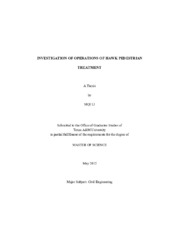| dc.description.abstract | High intensity Activated cross WalK (HAWK), as an innovative pedestrian-activated beacon, has become a hot topic and was introduced in 2009 Manual on Uniform Traffic Control Devices (MUTCD). According to the 2009 MUTCD?HAWK should be installed at least 100 feet from a stop-controlled intersection. This thesis first evaluates the distance between HAWK and stop-controlled intersection recommended by 2009 MUTCD. On the basis of the knowledge of HAWK operation, this thesis applies the Generalized Linear Model (GLM) to model the pedestrian delay at an HAWK location. The HAWK pedestrian delay model includes the major street arrival rate, minor street arrival rate, pedestrian arrival rate and the distance between HAWK and intersection. Four different functional forms are investigated in order to select an appropriate one that could more accurately model pedestrian delay. The minimum green time for vehicles, as an important variable in the HAWK pedestrian delay model and a peculiar element in HAWK operations, is also evaluated with VISSIM simulation based on different vehicle and pedestrian volume combinations. The impact of the HAWK on pedestrian delay is simulated by comparing pedestrian delay in scenarios with and without HAWK.
The results indicate that the minimum distance between HAWK and stop-controlled intersection recommended in MUTCD may be inadequate for high demand situations. More distance from HAWK to stop-controlled intersection needs to be considered in order to avoid vehicle spillback to the upstream intersection. Based upon the results of training and validating datasets, it can be indicated that the HAWK pedestrian delay model developed in this study is capable of effectively evaluating the pedestrian delay with a satisfactory accuracy. The study also identifies that a minimum green time for vehicles should be considered in order to reduce the vehicular delay and different minimum green times be provide for vehicles based on different pedestrian volume and vehicle volume combinations. A model of minimum green time for vehicles is then derived from HAWK pedestrian delay model. Finally, the study results indicate that a HAWK installation may increase pedestrian delay for the stop-controlled intersection scenario when vehicle demand is low. | en |


